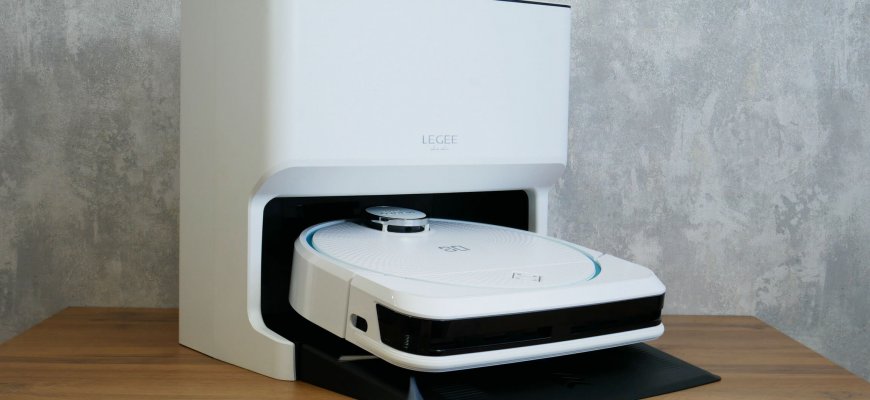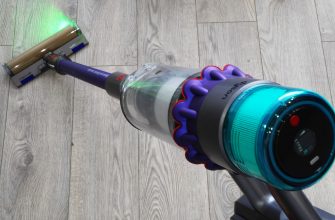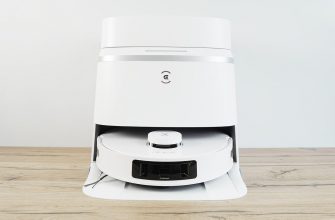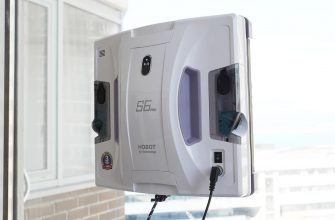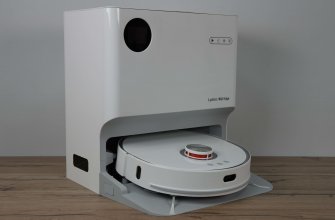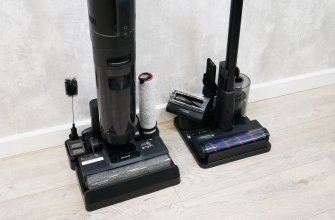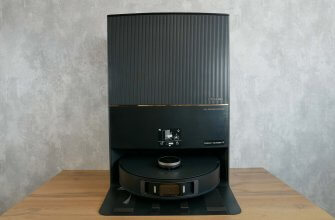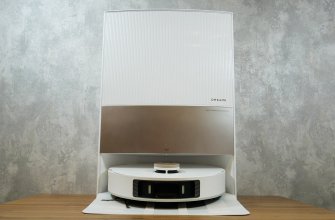Hey guys, welcome to Robotobzor! Today, we’ll review the station for the new Hobot LEGEE-D8 robot vacuum. It’s called Hobot LEGEE LuLu which will be available for sale in early July 2023. The price is expected to start at $240. This station can be optionally added to the vacuum, and it’s very convenient. But the most important thing is LEGEE LuLu’s functions. So the station is designed to clean and rinse the cloth while the robot is cleaning, dry the cloth with hot air after the cleaning cycle, and automatically refill the tank in the robot with clean water. Hobot LEGEE LuLu greatly enhances the autonomy of the LEGEE-D8 robot and makes its job easier. Now I’ll show how the new station is organized, how everything works, and test how effective it is. Let’s get rolling!
Appearance
The station comes in black and white. It’s size is upon the screen (L*W*H – 486*410*390 mm (19x16x15.3 In). And note that the height with the raised lid is 60 cm (23.6 In.).
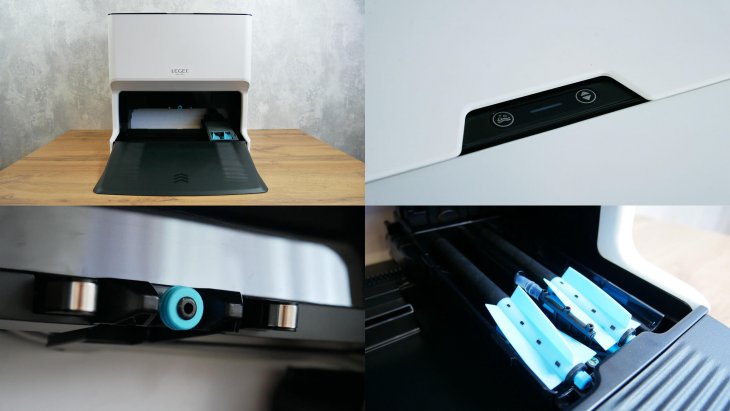
In the parking spot, the station has a platform for driving in, an attachment for filling the tank in the robot with water, charging points, a washing module and vent holes for drying the cloths. The platform is removable, it’s very easy to wash. The washing module is unique, like most of Hobot’s designs. Under the cover there’s two removable roller brushes with silicone paddles, three nozzles for water supply, as well as a tray for collecting and draining dirty water.
The idea is that water is applied to the cloth where the rollers spin, which move over the entire area of the cloth. The dirty water is immediately collected in a tray. This way the entire bottom of the station won’t get dirty. Pretty clever. The only thing left to do is to rinse the roller brushes from time to time and clean the small tray underneath them.
The self-cleaning process of the wipes also took its own spin. The washing module moves left and right inside the station, while the robot moves back and forth in the self-cleaning process. This ensures that the wipes are cleaned over the entire area. There’s no missed areas. The two brushes pass each section twice, first with water and again with extra water squeezing from the wipe, so that the wipe isn’t drenched. I’ll test how effective this really is later.
Beneath the top cover of the station are tanks for clean and dirty water. On the inside of the cover itself is a brief instruction manual for the station. Each tank has a capacity of 3.2 liters (.84 G.). The clean water tank has an additional lid with a sealed valve for adding detergent or water without removing the tank from the station.

The last thing I’ll focus on is the control panel. There’s two buttons on it: to start self-cleaning and to dock/undock the robot. The latter will come in handy if you need to service the robot. It’ll move out of the station on its own, so you don’t have to get it manually.
All in all, the station is well made. Pretty cool features popped out to me, but I’ll go over what I liked and didnt in the end.
Functions
As for the functionality of the LEGEE LuLu hobot, it’s automatically recognized by the robot, resulting in new functions in the menu. On the main screen, a “LuLu” section has appeared at the bottom left of the screen, which, when tapped, offers the possibility of manually starting the washing or drying of the cloths. The “LuLu” section has also appeared in the menu and it already has more settings. You can turn the function on or off to rinse the napkin, turn on or off the hot air drying, adjust the time of drying the napkin (from 2 to 4 hours) and most importantly – adjust the frequency of rinsing the napkin. So here it’s offered to wash once after the cleaning cycle, by time (from 30 to 360 min), as well as after cleaning each selected zone on the map.

Personally, I miss the ability to select a smaller time interval for the wash, such as every 5, 10, or 15 minutes. And also the ability to customize how often a wipe goes through a given cleaning area. Again, every 10 or 15 square feet. This would give more flexibility in adjusting the wipe wash function to suit yourself. The recommendations have been passed on to the brand representatives. Hopefully, they will add more flexible station settings in the future
And one more important thing – if you have selected the cloth washing mode after each cleaned zone, it’ll work only when you start cleaning in the selected zones. If you use the auto cleaning mode, the robot won’t rinse the cloth after each cleaned zone. Not very convenient, in my opinion. Again, recommendations passed on to the brand.
Testing
Before we start,let me show you a few points. First, the station comes with a rubber cover with a sealed valve for the robot. It is white in color. You need to replace the blue cover with a white one, per the instructions. And in general, in a good way, before the first start of the hobot LEGEE D8 with LuLu station, read the instructions carefully.

The second point has to do with the water quality that should be poured into the LEGEE LuLu hobot. The manufacturer equips the station with a special TDS water tester – salt meter. By the way, this express water quality tester can also be used for other household purposes, such as determining the quality of water for drinking and cooking. You can easily find tables with recommended values on the Internet.
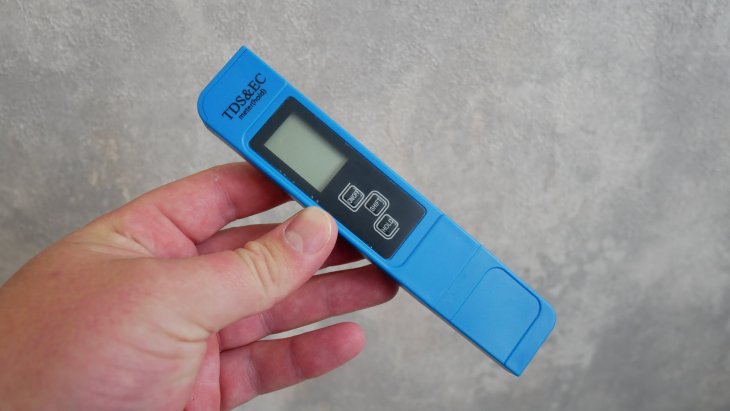
So, you can’t fill the LEGEE LuLu station with distilled water with a salt content lower than TDS 5 ppm. This is because the overflow sensors won’t work. Ideally, water with a salt content between 5 and 300 ppm should be used. Exceeding the normal salt content will affect the quality of the cleaning, may cause streaking after the salt water dries, and may cause the water spray attachments to clog over time. This can be solved by cleaning or replacing the attachments, which are included in the kit.
First, I poured tap water into the tank, tested it with a tester, and it showed 477 pm. It’s not recommended to water that high. Next, I poured tap water into the tank, just through the filter. Here’s something intresting. I have a three-stage filter, the simplest. And even after passing through it, the salt content didn’t decrease, exactly the same 477 pm. Consider this. Reducing the content of salts allows 4, and a better 5-stage filter with reverse osmosis purification. Or at least a water softener cartridge. Then I filled the tank with bottled water. Only then did the tester show the required 46 ppm. Another interesting point – in the tank with clean water, I added Hobot detergent in a ratio of 1:50, i.e. 60 ml per full tank. And even when mixing the water with the detergent, the salt content did not change, which indicates that the composition of the detergent is correct, without harming the robot.

Now I’ll show Hobot LEGEE LuLu Station doing its job. Here’s how the rinsing of the cloth after each cleaned area looks in reality. You can see that the robot returns to the station, rinses the cloth and continues cleaning with a clean cloth in a new zone.
The main test – we check the quality of washing the cloth after washing the floor in very dirty room. Hobot LEGEE D8 has managed to scrub the dirt.

We see that the cloth is very dirty after cleaning. We return it to the station, start washing the cloth, then start the function to move out of the station with a button on the control panel, turn it around and look at the result. Visually, the cloth is almost clean, not perfectly, per the edges, but clean. But I can say that in a similar test, other models didn’t do better. We check the cleanliness of the napkin under the faucet and see that a very small part of the dirt is washed out. Again, as with others. I can say that the washing quality of the napkin is good. In everyday conditions, with less serious cleaning, the washing quality is close to ideal.

By the way, for those interested, the water consumption for rinsing the cloths is 150 ml (5 Oz.). With other models it’s about the same: 150-220 ml (5-7.5 ml). It takes about 5 minutes, but with similar models, as a rule, about 2.
As for the condition of the station after the test, we see that the entire floor around the wash module is indeed absolutely clean. Nothing splashes or drips past the tray. We remove the cover and see that a small amount of dirt remains on the roller brushes and in the drain tray. Everything is easily wiped off with a damp cloth or napkin. But it’d be even better if the tray were removable.

The drying quality of the wipes has been tested. In my conditions, with high humidity in the room, the napkin is perfectly dry in 4 hours. The station doesn’t smell, which is good. If you live in a dryer region, perhaps 3 or even 2 hours will be enough to completely dry the wipe. The drying time settings allow you to choose the cycle time for your own conditions.
And I also tested the volume. So it’s within 65-66 dB when washing cloths and 51-53 dB when drying. Again, the station cannot be called too loud or too quiet. Everything is pretty standard.
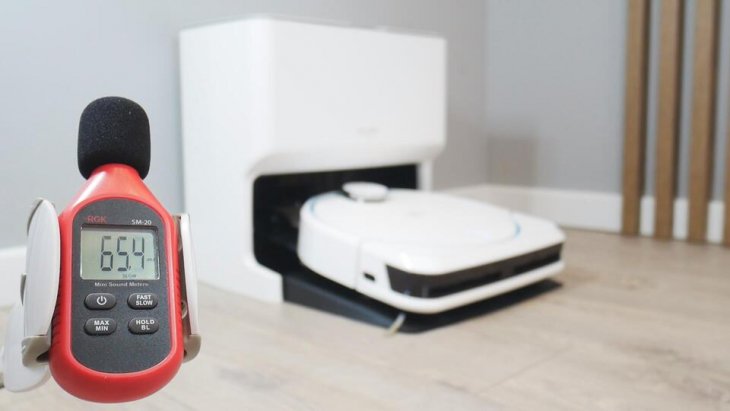
Opinion
Hobot LEGEE LuLu station, which is compatible with the Hobot LEGEE D8 robot vacuum cleaner, was thoroughly tested. I’ll highlight the pros and cons that I found. I liked the following:
- Compact.
- Good wipe cleaning
- Full wipe drying with hot air.
- Easy to clean and maintain.
- Optimal tank size taking into account water consumption. According to the brand, if you start washing the wipes only after cleaning, the tank with clean water with refilling is enough for 16 washes of the floor of a small apartment, i.e. if you wash the floor 2 times a week, the tank will last up to 60 days without maintenance.
- And separately I’d like to emphasize how unique it is. It has developed its own method of washing napkins, unlike other brands. This deserves praise.
As for what could be improved, here’s what I found:
- Can’t connect to sewage and water.
- The detergent doesn’t automatically feed when wiping the cloths, it has to be poured in.
- No flexible wipe cleaning intervals. Needs to have shorter intervals.
The first two comments aren’t life or death. But a more flexible setting of the station parameters is something the engineers should work on. Although the brand has its own opinion on this matter, and they’re convinced that due to the design of the cleaning module, especially in the spraying of water in front of the cloth, Legee D8 doesn’t need frequent cloth washing, and in their opinion it is enough for this robot to wash the cloth only after the cleaning cycle. Even if it will be an area of about 100 square meters (328 Ft.). I think otherwise, but let me know what you think in the comments below!
By the way, if you rate the Hobot LEGEE D8 with LuLu station, it scores 169 points according to our rating system and is in the top 20 best robot vacuums tested on Robotobzor. If they add more flexible station settings, I’ll add another 2 points to the overall rating.
All in all, I like it. I’ve been waiting for it for a long time and now Hobot LEGEE D8 is actually more convenient, autonomous and able to clean the floor on large areas. Definitely recommended to purchase! It’s important to note that the retail price of the robot Legee D8 is $420, so the full set with the station will cost $660. Considering the high efficiency and versatility of the model, a number of advanced design solutions and the availability of a full warranty, as well as after-sales service, the price is pretty good. There’s not many models that live up to this price.
On that note, I’d like to end the review. If you have questions, leave them in the comments below. Have fun shopping, bye!

